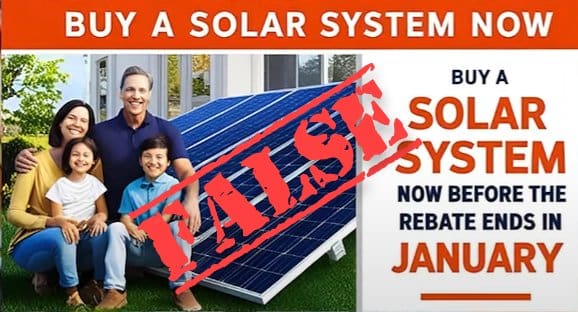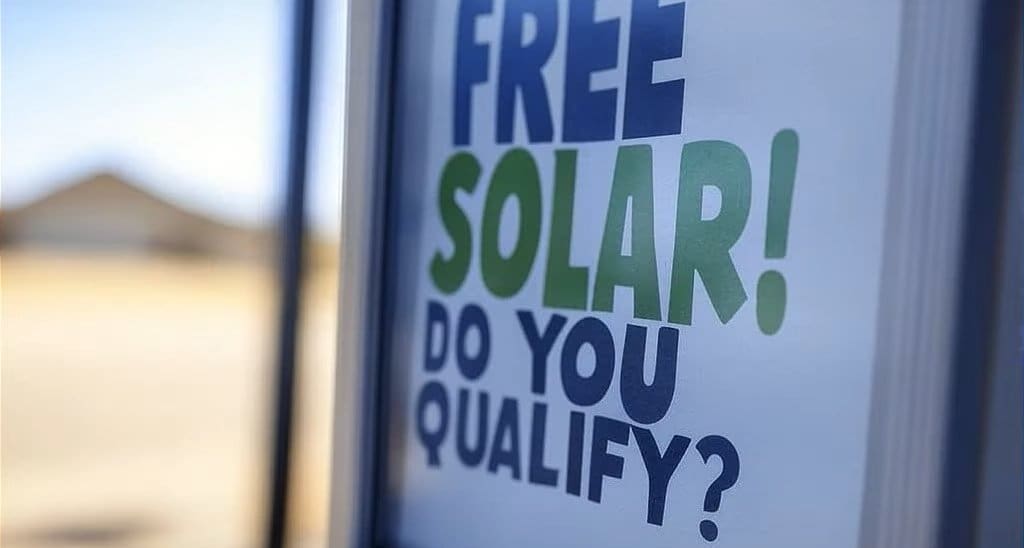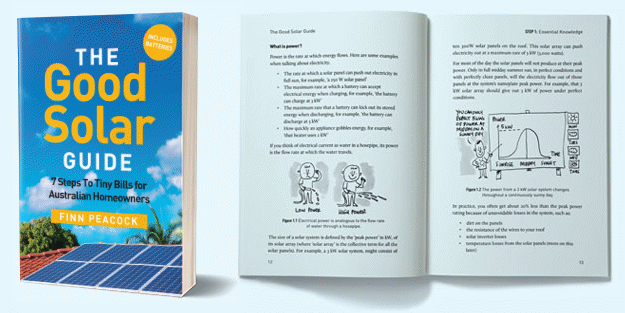Learn how Australia’s solar panel rebate works and how to avoid heartache, headaches and hip pocket pain by recognising shonky ads.
We recently reported on misleading battery rebate ads becoming commonplace. But dodgy solar panel rebate advertising has been going on for a lot longer, and unfortunately continues because it works.
First, it’s important to understand what the solar rebate is and isn’t.
How The Solar Rebate Works
While it’s been widely called a rebate for many years and the term has stuck, a rebate is something you would usually receive *after* a purchase. In practice, this incentive is actually an up-front discount on a qualifying solar power system purchase.
The subsidy is provided under Australia’s Small-scale Renewable Energy Scheme (SRES) — a government initiative to encourage investment in renewables. When you install eligible renewable systems (in this case, rooftop solar power), Small-Scale Technology Certificates’ (STCs) can be created and sold, and their value fluctuates with market conditions.
The number of STCs accompanying a qualifying system is based on:
- The size of the system – its solar panel capacity in kilowatts (kW).
- The year it was installed.
- Where in Australia it was installed.
While system owners can sell STCs themselves, there’s a bit of work involved. Just about everyone chooses to instead assign the rights to their STCs to the installer, or a registered agent acting for the installer, on the day of installation — and that value minus administration fees is provided as the up-front discount. When you see prices advertised for solar systems, this value is already taken into account.
SolarQuotes founder Finn Peacock explains this in further detail in the video above; or you can read more about it in our solar panel rebate guide.
But even after all these years of the rebate being available, we’re still seeing people falling victim to misleading advertising.
The Rebate Is Not ‘Ending Soon’
Despite what some pushy salespeople and advertising tells you, the solar rebate isn’t vanishing anytime soon.
But the STC scheme is phasing out, ending in 2031. The number of STCs a system is eligible for drops at the beginning of each year. You can see this effect by tinkering with the SolarQuotes STC calculator.
But the good news is STC decreases have generally been offset by the cost of solar systems dropping – so there’s no need to rush out and buy a system purely based on these misleading ads.
Free Solar Based On Postcode Is BS
There has also been a proliferation of shonky solar ads — both online and offline — claiming the rebate means you get the solar system for free, and you qualify for it based on where you live.
First, all Australian postcodes are eligible — it doesn’t matter where you live in Australia.
Second, these systems are not free. What these ads usually offer is a cheap, crappy system for ‘no money up front’. But that just means they are loaning you thousands of dollars to buy the system. You will be making weekly or monthly payments that often make this purchase one of the most expensive solar systems you can buy.
Finn’s seen deals for systems that would usually cost $6,000 where the repayments add up to $22,000.
Misleading Solar Ads A Warning Sign
If a company is using misleading advertising regarding the rebate, it can be a big red flag about their approach to solar and after-sales support generally. Even if the firm is using good quality solar panel and inverter brands, the best gear (and your home) is at risk from sloppy installation and potentially dangerous shortcuts.
For example, cracked tiles can happen even with the most careful installers on your roof. But a good installer will tell you what’s happened and take action to properly fix the situation1. A shonky installer might just ignore it or stick a broken tile together with glob of silicone and hope for the best without telling you; only for the bond to fail down the track. Rushed and poor-quality electrical connections can also be a risk, creating a fire hazard that could have disastrous results.
Poor installation might not have an impact immediately. By the time issues become apparent, the company may have disappeared, or it can be very difficult to get a resolution for a situation that shouldn’t have occurred in the first place. Meanwhile, you and your hip pocket suffers through having an under-performing or malfunctioning system, not to mention the stress involved in trying to get it resolved.
Finn says:
“Based on how misleading these ads are, I have zero confidence in the quality of the installers they’d recommend if you submitted your details.”
If you want to avoid having to navigate what can be a minefield when selecting a company for your installation, consider using our free quoting service backed by the SolarQuotes Good Installer Guarantee.
Footnotes
- It’s always a good idea to have spare tiles on hand on installation day, and let the installer know you have them. ↩



 RSS - Posts
RSS - Posts



Speak Your Mind